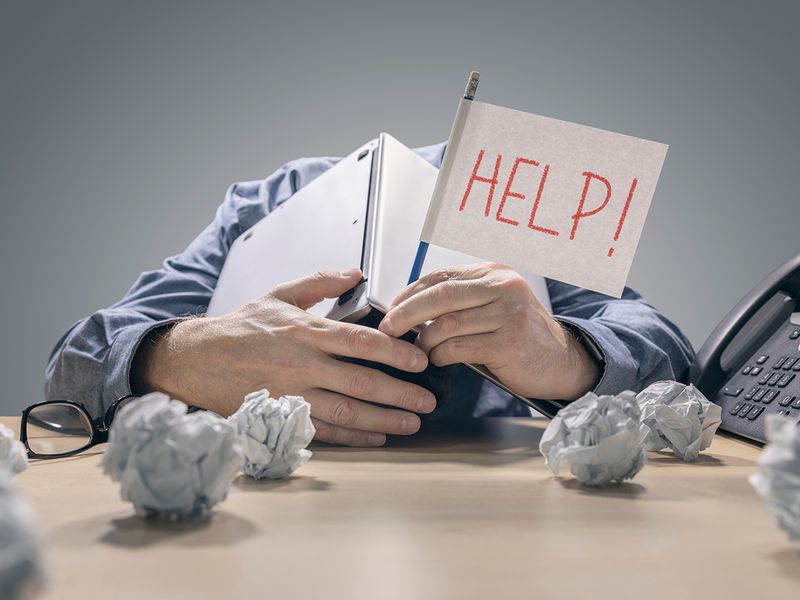
A cycle of sluggish toxicity. An exhausting hamster wheel.
That’s how thirty-five-year-old Elena Thomas (name changed on request), an Abu Dhabi-based marketing manager describes the past few years of her professional life. “I feel like I’m constantly running on fumes,” says the American expat. It’s a day-to-day survival; she says she doesn’t ‘plan’ for the future anymore. She doesn’t like her job at all, but at this point in her career, she doesn’t know what else to do. “I’ll just go with it, for now. It’s an atmosphere of listlessness, and everyone else in office seems to feel the same way. So it gets to me even more,” she adds. This feeling became far profound after the Covid-19 pandemic, after she had to work extra weekends, on low incentives, and no appreciation, but demands to deliver far more unrealistic targets.
Maria Elizabeth, a British expat in her late forties, recalls the amount of sudden “sick” leaves she has had to approve in the past two years. “And if the employees can’t take leave, they come into work, looking demotivated and lack energy. They don’t sleep properly, and then they make errors. And then they have to stay late and fix the damage they caused. Some blame the organisation, while others go into this battle of self-blame. It goes on, like this endless cycle, and in such fast-paced environments, no one has the patience to sit with anyone and talk. So it continues,” adds Elizabeth, a senior marketing manager based in Abu Dhabi.
This feeling of demotivation, listlessness and perpetual exhaustion, is what’s called a burnout. It’s far more than just the ordinary Monday blues.
What is a burnout?

In this state of burnout, a person lacks motivation and has no joy in what they do. They face emotional, physical and cognitive fatigue, which doesn’t let them feel content with what they’re doing.
This could emerge from intense workloads, being permanently available to managers, or feeling the lack of control over work, and believing you don’t have the skills to accomplish targets. American psychologist Herbert Freudenberger described it in his 1974 article as a sense of depersonalisation, which leads to gradual disengagement. There’s a sense of growing cynicism, even callousness as you psychologically distance yourself from work, and feel detached and negative towards it. Another symptom of burnout is a feeling of inefficacy, where the person is sure that they can’t perform and won’t be able to succeed. They’re filled with a sense of failure and self-doubt.
The problem of burnout has become so severe in the past few years that the World Health Organisation (WHO) declared it as an occupational phenomenon in 2019. The organisation defined burnout as a syndrome that had been conceptualised as resulting from workplace stress that has not been successfully managed. According to a 2023 survey by Gallup, an American data and analytics company, 23 per cent in 7500 employees reported feeling burned out. If they do not call in sick for work, their productivity reduces by 13 per cent.
Why do people feel burned out?

It’s a complex web of reasons that could culminate in a person’s exhausted mental state at the workplace. There can be two perspectives on how to view burnout, which includes understanding the work environment itself, and secondly, the conflicts within the person, themselves.
While burnout can emerge from overwhelming stress, it is also the result of different specific types of stress, apart from many job-related factors. “The rapid global spread conceals a deeper crisis, as 80 per cent of the world grapples with low self-esteem,” explains Flora Castillon, a mindset coach, wellness expert and psychologist. “This internal conflict obstructs self-care and overall well-being, resonating across workplaces, economies and personal lives,” she says.

The rapid global spread of burnout conceals a deeper crisis, as 80 per cent of the world grapples with low self-esteem. This internal conflict obstructs self-care and overall well-being, resonating across workplaces, economies and personal lives...
Castillon explains the three adversaries that fuel the burnout struggle, which include, limiting beliefs, impostor syndrome and unaddressed stress. “Limiting beliefs, which are about the way we see and feel about ourselves, are formed in childhood and erode adult potential,” she says.

People also suffer from imposter syndrome, which is a condition of anxiety where a person doesn’t feel success internally, despite being high-performing externally. “It affects many, generating feelings of inadequacy despite achievements. These constructs push us to exceed limits, forsaking self-care due to a relentless fear of falling short. While external pressures play a role, the ceaseless internal dialogue, the critical voice, fans the flames, eroding emotional and psychological well-being,” says Castillon.
Elaborating further on these ‘internal monologues’, Shaju George, a psychiatrist at the Dubai-community Health Center, says, “There are people who are perfectionists. They tend to be workaholics, and they will do their best to deliver that hundred per cent. They will compromise on their sleep and food, in order to deliver the best despite all the limitations,” says George. And when they can’t, this fuels more anxiety and they feel like failures.
As a person misunderstands stress and ignores the symptoms that lead to burnout, the mind is gradually unable to distinguish the real-life threats from perceived stress, which is subjective. As a result, they feel extreme fatigue, experience poor performance and mental withdrawal, which leads to chronic diseases.
‘Squeezing out the output’
While people battle with various raging internal conflicts, they have to also contend with high-pressure work environments at their organisations. There are several ways in which the workplace contributes to a person’s burnout as well.

There are people who are perfectionists. They tend to be workaholics, and they will do their best to deliver that hundred per cent. They will compromise on their sleep and food, in order to deliver the best despite all the limitations...
According to George, the constant trimming down of workforce in several organisations, especially after the pandemic, has also put immense pressure on the workforce. “In many parts of the globe, there is also a financial slowdown. Companies are reducing their staff size, and they’re expecting the same outcome and output from the reduced team. If the expectation is the same and the staff is less, this adds to more anxiety and pressure as they work harder to deliver impossible targets,” he explains.
In many offices, there are rather unclear requirements for employees, and if the expectations regarding tasks are unclear, they risk burning out quickly. Employees don’t get much downtime, and they have to handle a difficult workload for a long period of time. In this tired state, they make errors, which tend to have grave consequences, and this adds to the stress of their workload. Leadership is also crucial for the mental health of an employee. If an employee feels undervalued, unrecognised, despite working so hard, they can risk burnout too.
Organisations tend to “squeeze out” a certain level of output from the employees, which leaves them more exhausted and worn out from before, adds George. The pandemic fueled this feeling, owing to the downsizing in many firms, which made people realise that they had to work much harder than they had been, for their livelihood. Coupled with lack of incentive, appreciation or insufficient compensation, a person loses the will to work in such an environment.
‘Hanging on by a thread’
Moreover, feelings of low self-esteem and inadequacy, are exacerbated by the ‘hustle’ attitude in a workplace. “Our culture and society rewards the ‘hustle’. The pushing, the striving, the running and working all hours to prove we are committed and ambitious,” says Emma Burdett, a Dubai-based transformational coach and wellness expert. “It’s the masculine notion of striving and forcing with assertiveness and aggression. What society does not teach us, is to create space for ourselves. Taking time to nurture our well-being and mental health with exercise, meditation and nutritious food,” she says.

What society does not teach us, is to create space for ourselves. Taking time to nurture our well-being and mental health with exercise, meditation and nutritious food...
Burdett recalls rather unpleasant experiences in her career, which resulted in her falling off the stage while giving a keynote speech. “I had left the corporate world a few months before to embark on the entrepreneurial journey full time,” she says. “Running from one meeting to the next, to zoom calls, to hosting, curating and speaking at events; coaching clients in between. I planned and executed four world class events in four months until one day; crash, bang, I fell off a stage whilst giving a keynote, in tears,” says Burdett. Friends instantly noticed her condition and realised that she was hanging on by a thread. Feeling depressed, apathetic, detached and without any motivation, finally, Burdett did what she had to do: She took a break, went for a holiday, and worked on re-centering herself before returning to work.
How does one address burnout at the workplace?

In order to address burnout, there needs to be responsibility at the individual as well as the organisational level. While organisations need to evaluate their stance on working and flexible hours, here’s what a person can do for themselves:
Challenge limited beliefs
Additionally, we also need to take responsibility for our own health and well-being. Asserting boundaries, learning to say no and taking care of ourselves is a start, says Burdett. Alter self-talk, introduce self-praise to bolster self-worth, recognise your success, and heal traumas, suggests Castillon. Stop being so critical and cruel to yourself and reward yourself when you can. Reset the expectations of colleagues and managers, so that people know how much you can take on. You will get backlash at first, but it will help you in the long-term productivity and protect your health.
Understand how you are feeling, through regular journaling, meditation and mindfulness, says Anushka Patchava, co-founder Wellx, a start-up that ensures a healthy lifestyle for policyholders in the UAE. "It helps to recognise and spot burnout and its debilitating symptoms early. ‘We often feel we are too busy to stop. ‘However stopping and reflecting is exactly what we need to do to give ourselves space to understand our body, our mind and how we are feeling," she says.
Practice Self-Care
Set clear work-life boundaries, and prioritise rejuvenating activities, like sports, suggests Castillon. Reconnect with values and create interests beyond work. "Critically, one of the key factors in burnout is feeling overwhelmed and undervalued. By doing something for yourself, focusing on you, you may be able to negate some of these negative emotions," says Patchava. "Getting the basics right like good sleep hygiene, daily exercise, appropriate nutrition and hydration has been shown to improve burnout, at least in the immediate, acute phase and help you shift your perspective," she adds.

Critically, one of the key factors in burnout is feeling overwhelmed and undervalued. By doing something for yourself, focusing on you, you may be able to negate some of these negative emotions. Get the basics right like good sleep hygiene, and daily exercise...
If you find it difficult to introduce such activities into your packed schedule, give yourself a week to assess exactly how you’re spending your time. For each time period, observe what you are doing, how long you are doing it for and whether the activity is worth your time. This will help you reduce the amount of time you invest in something that drains you of energy.
Creating safe workspaces
While the onus is on the individual to speak up, managers and leaders also have a responsibility to not only be alert to burnout characteristics in their employees, but also be sympathetic to them, and articulate in a safe environment that talking about these issues won’t lead to demotion, lower bonuses or worse, job loss, adds Patchava. "Creating psychologically safe workspaces, with good provision of mental health support is key to reducing burnout and it’s effect. In addition, offering flexibility for the individual, and autonomy can help improve feelings of burnout. Sometimes space and time are the biggest healers," she says.
Evaluate your perspective
When you’re in office, take a look at your own mindset. Evaluate the tasks at hand, and see what you can delegate to free up time for other work. Ask yourself important questions, on what about your situation is fixed and what can be changed, and how you can look differently at your job in order to gain control of the situation again.
(Note: This article was first published on August 17, 2023)









